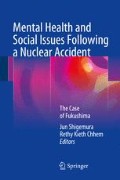Abstract
The legal system regulating nuclear power generation in Japan had never taken into account the possibility of an accident as severe as the Fukushima accident. There were no countermeasures in place to respond to such an accident, which left people and agencies in confusion in a time of great need. By delaying the provisioning of well-considered countermeasures, Japan has not been able to adopt them properly and in a timely fashion. Even if there had been such proper countermeasures in place, the manner in which the response occurred after the accident made it hard for authorities to gain the trust of citizens. Agencies that regulate power companies and ensure the safety of nuclear power generation are part of the same governmental organisations that promote nuclear power. Therefore, the regulatory organisations had no other choice but to be passive in creating appropriate regulations on nuclear power. The disaster prevention drill that had been held before the accident was of no help in evacuations during this nuclear accident, as only small-scale accidents had been considered in the drill. Evacuation standards and food safety standards were put in place only after the Fukushima accident; simultaneously, the processing of radioactive waste was placed outside the jurisdiction of the Ministry of the Environment. The fact that there were no specific standards for compensation increased the burden and anxiety of victims. It is critical to learn the lessons of Fukushima and create specific legal disaster countermeasures based on the assumption that a severe accident can and will occur again sometime in the future.
Access this chapter
Tax calculation will be finalised at checkout
Purchases are for personal use only
References
Yokodaidou S. Nuclear and Industrial Safety Agency and Nuclear Safety Commission (in Japanese). Hougaku Seminar. 2011;682:13.
Fukushima Prefecture. Efforts towards ensuring the safety of nuclear power plants in the future (in Japanese). June 2005. http://www.pref.fukushima.lg.jp/download/1/sonota_H170629_2.pdf. Accessed 15 Jan 2015.
METI Nuclear and Industrial Safety Agency, Nuclear Emergency Preparedness Division. Risk management for nuclear power disasters (in Japanese). Houritsu no Hiroba. 2002;55(3):28–35.
Matsuno G. Nuclear Emergency Preparedness; in order to deal properly with all nuclear risks (in Japanese). Tokyo: Soueisha & Sanseido; 2007. p. 111.
NSC. Nuclear emergency response guideline: disaster response for nuclear power facilities (in Japanese). http://www.nsr.go.jp/archive/nsc/anzen/sonota/houkoku/bousai220823.pdf. Accessed 15 Jan 2015.
Investigation Committee on the Accident at the Fukushima Nuclear Power Stations of Tokyo Electric Power Company. Investigation Report, Interim Report. 2012. p. 581. http://www.cas.go.jp/jp/seisaku/icanps/eng/120224Honbun07ng.pdf. Accessed 15 Jan 2015.
The Official Report of the National Diet of Japan Fukushima Nuclear Accident Independent Investigation Commission. Tokyo: National Diet of Japan; 2012. chap.4, pp. 29–38. http://warp.da.ndl.go.jp/info:ndljp/pid/3856371/naiic.go.jp/en/report/. Accessed 15 Jan 2015.
Yasumura S. Evacuation effect on excess mortality among institutionalized elderly after the Fukushima Daiichi Nuclear Power Plant accident. Fukushima J Med Sci. 2014;60(2):192–5.
Disaster Prevention Study Group for Those with Disabilities. Collection of disaster prevention advice for those with disabilities (in Japanese). Fukushima: Iwaki Jiritsu Seikatsu Center; 2014.
The Official Peport of the National Diet of Japan Fukushima Nuclear Accident Independent Investigation Commission. Tokyo: National Diet of Japan; 2012. chap.4, p. 67 http://warp.da.ndl.go.jp/info:ndljp/pid/3856371/naiic.go.jp/en/report/. Accessed 15 Jan 2015.
Yamaguchi S. Issues and efforts in preventing nuclear power disasters (in Japanese). National Diet Library Issue Brief. 2013;801:1–13.
Nuclear Regulation Authority. Information on former Nuclear and Industrial Safety Agency (in Japanese). http://www.nsr.go.jp/archive/nisa/faq/faq_a09.html. Accessed 15 Jan 2015.
Fukushima Minpou. Farmers fears undiminished: confirming safety of seven greenhouse products from Fukushima prefecture (in Japanese). 28 March 2011. http://www.minpo.jp/pub/topics/jishin2011/2011/03/post_182.html. Accessed 15 Jan 2015.
Fukushima Minpou. Food standards become stricter starting 1st of April (in Japanese). 1 April 2012. http://www.minpo.jp/pub/topics/jishin2011/2012/04/post_3578.html. Accessed 15 Jan 2015.
Kodera S. Issues regarding radioactive contamination and processing of contaminated waste: the Fukushima Daiichi Nuclear Power Plant accident; its impact and countermeasures (in Japanese). National Diet Library Issue Brief. 2012;743:1–13. p. 10.
Fukushima Minpou. Neighbouring district also voices opposition to facilities (in Japanese). 10 June 2014. http://www.minpo.jp/pub/topics/jishin2011/2014/03/post_9430.html. Accessed 15 Jan 2015.
Fukushima Minpou. Residents in the county of Futaba have mixed emotions about interim storage facilities (in Japanese). 3 March 2014. http://www.minpo.jp/pub/topics/jishin2011/2014/06/post_10153.html. Accessed 15 Jan 2015.
Fukushima Minpou. Survivors in the city of Sukagawa settle with TEPCO (in Japanese). 2 June 2013. http://www.minpo.jp/pub/topics/jishin2011/2013/06/post_7300.html. Accessed 15 Jan 2015.
Fukushima Minpou. TEPCO suit by dairy farm survivors in the city of Soma seeks 126M yen (in Japanese). 31 May 2013. http://www.minpo.jp/pub/topics/jishin2011/2013/05/post_7288.html. Accessed 15 Jan 2015.
Nuclear Damage Compensation Dispute Resolution Centre. Decision regarding comprehensive criteria (in Japanese). 14 February 2012. http://www.mext.go.jp/component/a_menu/science/detail/__icsFiles/afieldfile/2012/12/20/1329129_001.pdf. Accessed 15 Jan 2015.
TEPCO. Press release. On compensation for costs related to voluntary decontamination (in Japanese). 18 September 2014. http://www.tepco.co.jp/cc/press/2014/1242022_5851.html. Accessed 15 Jan 2015.
Author information
Authors and Affiliations
Corresponding author
Editor information
Editors and Affiliations
Rights and permissions
Copyright information
© 2016 Springer Japan
About this chapter
Cite this chapter
Fujino, M. (2016). Unforeseeable Accidents from the Point of View of the Legal System. In: Shigemura, J., Chhem, R. (eds) Mental Health and Social Issues Following a Nuclear Accident. Springer, Tokyo. https://doi.org/10.1007/978-4-431-55699-2_2
Download citation
DOI: https://doi.org/10.1007/978-4-431-55699-2_2
Published:
Publisher Name: Springer, Tokyo
Print ISBN: 978-4-431-55698-5
Online ISBN: 978-4-431-55699-2
eBook Packages: MedicineMedicine (R0)

